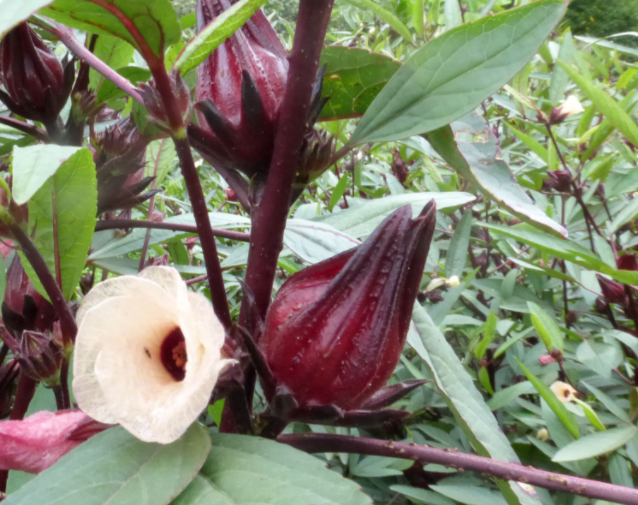Now that the hot weather has really begun to set in it’s time to focus on heat loving crops. While many people will be setting out peppers and seeding melons there’s another summertime crop that deserves a place in your garden, roselle. The roselle plant is a member of the hibiscus family grown for its flavorful calyxes (part of the flower). It’s not as showy as ornamental hibiscus varieties but it is extremely useful.
It offers a citrus flavor earning it another common name, the Florida Cranberry. Roselle can be used for candies, syrups, or jam but it’s probably best known for its use in making delicious, bright red tea called Red Zinger. The tea has more going for it than just being tasty though. Roselle has long been used to safely lower blood pressure and is full of vitamin C.
The young leaves and stems of the roselle plant can also be used as salad or cooked greens or be made into jam as well. The leaves are naturally high in pectin, prefect for jam.
While Roselle is technically a perennial it is extremely frost sensitive so here in Virginia (zone 7a) it’s grown as an annual. Roselle can be started early and transplanted, much like tomatoes, or it can be direct seeded during hot weather. It requires temperatures between 75°- 85°F to germinate but germinates readily outdoors making it an ideal candidate for direct sowing.
Roselle will do best in well-drained, fertile soil. Compost amendments are fine but beware of over-fertilizing. Too much nitrogen can cause it to put energy into growing a very large plant instead of many calyxes. Be sure to keep your roselle plants well weeded until they’re established and can shade out weeds by themselves.
Tips for Direct Sowing
- Plant extra seeds and thin later choosing the best looking plants to keep. This will ensure you get a good crop of healthy, hardy plants.
- Water, water, water! Do not forget to water your roselle especially while the seeds are germinating.
- Watch the weather and make sure your area has warmed up enough!
If you’re going to direct sow and thin your plants (or have plants ready to set out) it’s important to give Roselle a lot of space. Plants should be thinned to 3 ft apart in rows 5 ft apart. It sounds like a lot but plants with less space will produce less calyxes.
Pests aren’t typically a big problem with roselle though it can be susceptible to stem and root rot. Both are easily avoided by planting in well drained soil and carefully monitoring watering to avoid over doing it.
Thai Red Roselle, the variety grown at Southern Exposure, should begin flowering in the mid summer. Calyxes can be harvested after the blooms drop off and are most easily harvested when full grown but still tender. If they’re not tender enough to break off by hand you can use clippers.
For high quality tea calyxes should be removed from the seed and dried out of direct sunlight. A dehydrator can be helpful especially in very humid weather. Once completely dry they can be stored in airtight jars for making tea throughout the year.
If you’d like to try your hand at growing roselle there’s still time to direct sow! Find Southern Exposure’s Thai Red Roselle seed here.

